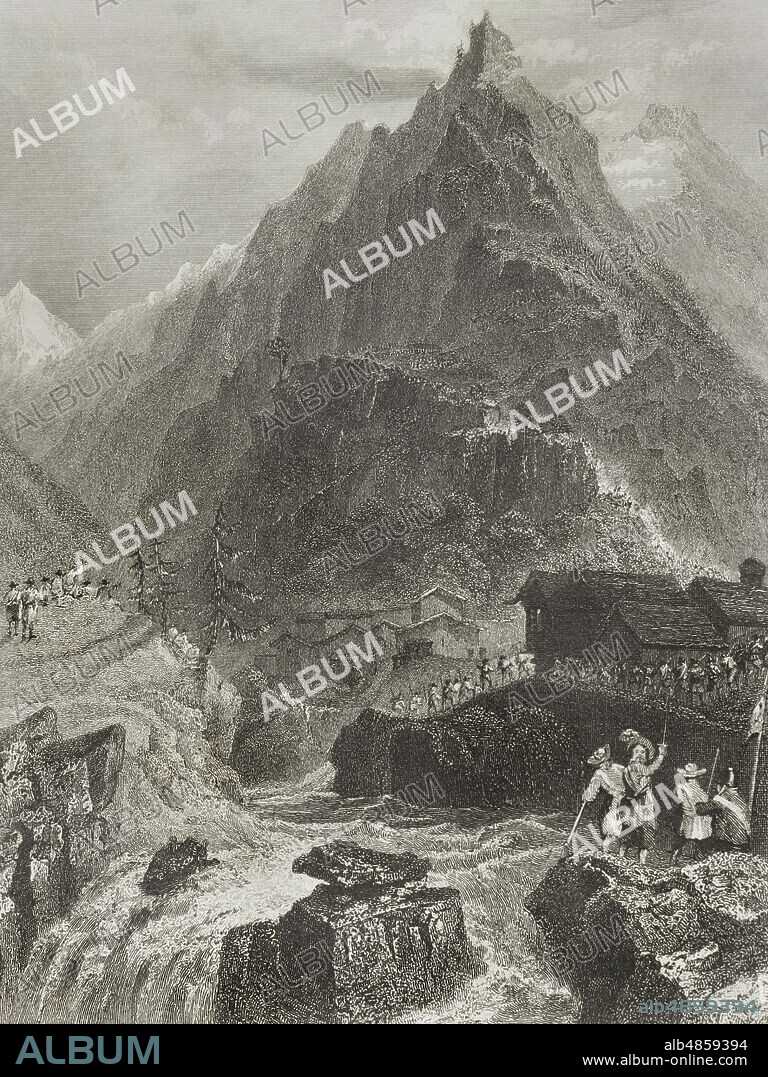alb4859394
ANTONIO ROCA SALLENT (1813-1864). SPANISH ENGRAVER.. Persecution of the Waldensians (1540-1570). The Waldensians are followers of an ecclesiastical tradition that began as an ascetic movement within Western Christianity before the Reformation. In 1215 they were declared heretics. Pope Innocent III offered them the chance to return to the Church. Many of them did so, the so-called "Poor Catholics". Those who did not accept were subjected to great persecution. In the 16th century, the Waldensians were absorbed into the Protestant movement, under the influence of the early Swiss reformer Heinrich Bullinger. They were aligned with Protestantism. With the Resolutions of Chanforan on 12 September 1532, they formally became part of the Calvinist tradition. Pradeltorno attack, 16 February 1561. The lord of Trinity stormed from three different points. It was a natural stronghold of very difficult access, at the top of the Angrogna Valley, which became the center of the Waldensian resistance. Village of Balziglia, Massello, in Piedmont. The defeated Waldensians had to flee to Switzerland and Germany. Engraving by A. Roca. Historia de las persecuciones políticas y religiosas en Europa (History of political and religious persecutions in Europe). Volume I. Published in Barcelona, 1863.

|
Add to another lightbox |
|
Add to another lightbox |



Buy this image.
Select the use:

Caption:
Persecution of the Waldensians (1540-1570). The Waldensians are followers of an ecclesiastical tradition that began as an ascetic movement within Western Christianity before the Reformation. In 1215 they were declared heretics. Pope Innocent III offered them the chance to return to the Church. Many of them did so, the so-called "Poor Catholics". Those who did not accept were subjected to great persecution. In the 16th century, the Waldensians were absorbed into the Protestant movement, under the influence of the early Swiss reformer Heinrich Bullinger. They were aligned with Protestantism. With the Resolutions of Chanforan on 12 September 1532, they formally became part of the Calvinist tradition. Pradeltorno attack, 16 February 1561. The lord of Trinity stormed from three different points. It was a natural stronghold of very difficult access, at the top of the Angrogna Valley, which became the center of the Waldensian resistance. Village of Balziglia, Massello, in Piedmont. The defeated Waldensians had to flee to Switzerland and Germany. Engraving by A. Roca. Historia de las persecuciones políticas y religiosas en Europa (History of political and religious persecutions in Europe). Volume I. Published in Barcelona, 1863.
Location:
PRIVATE COLLECTION
Credit:
Album / Prisma
Releases:
Model: No - Property: No
Rights questions?
Rights questions?
Image size:
3189 x 4250 px | 38.8 MB
Print size:
27.0 x 36.0 cm | 10.6 x 14.2 in (300 dpi)
Keywords:
1561 • 16 16TH XVI XVITH SIXTEENTH CENTURY • 16 CENTURY • 16TH CENTURY • 16TH • A. ROCA • ALPS • ANGROGNA VALLEY • ANGROGNA • ANGROGNIAN • ANTONIO ROCA SALLENT (1813-1864). SPANISH ENGRAVER. • ANTONIO ROCA SALLENT • ANTONIO ROCA • ARMIES ARMY • ARMIES • ARMY • ARMY: SOLDIER • ASSAULT • ATTACK • ATTACKING • BALSIGLIA • BALZIGLIA • CATHOLIC CHURCH • CATHOLIC RELIGION • CHRISTIANISM • CHRISTIANITY • CLERGYMAN • CLERIC • COTTIAN ALPS • CRISTIANDAD • CRISTIANISMO • DOCTRINE • ECCLESIASTICAL • ENGRAVED • ENGRAVING (ARTWORK) • ENGRAVING • ENGRAVING. • ENGRAVINGS • ETCHING • EUROPA • EUROPE • EUROPEA • EUROPEAN • EUROPEANS • FAITH • FEBRUARY 16 • HERESY • HERETIC • HERETICS • HISTORIA UNIVERSAL • HISTORIA • HISTORY • ITALIA • ITALY • LORD OF TRINITY • MASSELLO • MOUNT • MOUNTAIN • MOUNTAINS • MOUNTAINS. • NATURAL BASTION • NORTH OF ITALY • NORTHERN ITALY • PEOPLE'S ARMY SOLDIER • PIEDMONT • POOR OF LYON • PRA DEL TORNO • PRADELTORNO • PRINT • PRIVATE COLLECTION • PROTESTANT MOVEMENT • PROTESTANT • PROTESTANTISM • PROTESTANTS • PROVINCE OF TURIN • RELIGION • RELIGIOUS PERSECUTION • RELIGIOUS PERSECUTIONS • RELIGIOUS • RITE • ROCK • ROCKY • SIXTEENTH CENTURY • SOLDIER • SOLDIERS • SOLIDER • STONE • STONES • STORMING • TROOPS • VALDESI • VALLENSES • VAUDOIS • WALDENSES • WALDENSIAN RESISTANCE • WALDENSIAN VALLEYS • WALDENSIAN • WALDENSIANS • WARRIOR • WARRIORS • WESTERN CHRISTIANITY • XVI CENTURY • XVI
 Pinterest
Pinterest Twitter
Twitter Facebook
Facebook Copy link
Copy link Email
Email
